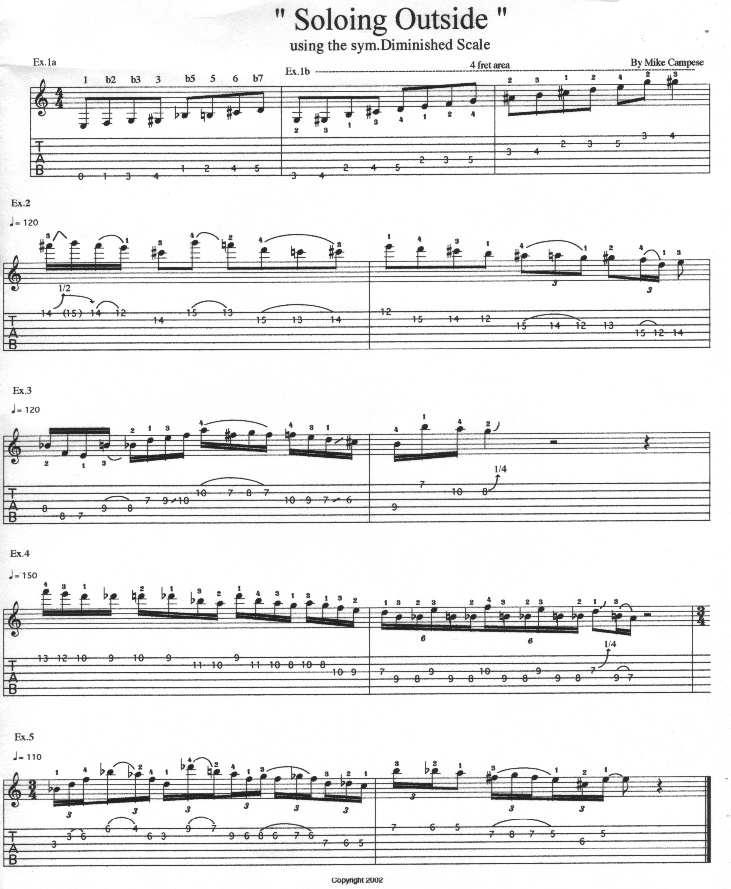Hello everyone! Happy holidays! OK, so by now you have all your scales down and you're using them in your solos. But you're saying to yourself, how can I add something different to my solos to sound a little outside? Today we are going to explore some cool uses for the symmetrical diminished scale. This is a 8 note scale built in a half-step/whole-step order. The diminished scale is usually used over functioning Dom7th chords (V-1), B7b9 - Em7 for example. But we are going to use this scale off the root on a 1 minor. For example, if you're using the Dorian scale you can weave the symmetrical diminished scale into the fabric for a bar or so, then resolve back to minor. For example, E Dorian, E sym Dim. Let me give you some examples.
Example 1a, 1b - Here we have the symmetrical diminished scale (1, b2, b3, 3, b5, 5, 6, b7) or (E, F, G, G#, Bb, B, C#, D).This scale is very patterny - to me it doesn't sound good played in order. In example 1b, we take a 4 fret area and learn the notes in that position. This breaks up the scale somewhat to make it sound more musical. Try this in other positions.
Example 2 - On this lick we use a E symmetrical diminished scale mixed with the E Dorian scale(1, 2, b3, 4, 5, 6, b7) or (E, F#, G, A, B, C#, D). Notice the C in the first bar, which is a passing tone leading to the C#. Try playing this lick over a static Em7 groove.
MP3 - Example 2
Example 3 - The thing about playing the symmetrical diminished scale off the root is that you can use the scale at the beginning of phrases and it sounds cool. Like in this example, we start off with the E symmetrical diminished and resolve to E Dorian. This scale is usually played at the end of phrases resolving to 1, in a V-1 progression. Always experiment! Also try this one over E Blues.
MP3 - Example 3
Example 4 - In this example, we start off with a 8 note sequence moving down the E symmetrical diminished scale then play a 16 note triplet pattern in the last bar. Try moving this example up in minor thirds; you will notice the same notes repeat. This is why it's called the symmetrical diminished scale - the same notes repeat in minor thirds. Make sure you pick every note.
MP3 - Example 4
Example 5 - Our last example. Another cool thing about this scale is that there are different 7th chords built off the root. For example: Dom 7th, Dim 7th, min 7th, min 7th(b5), Dom 7th (b5), etc. All these chords work up in min 3rds also, and you can arpeggiate them. So in E, you can use Edom7th, G dom 7th, Bb dom 7th, Db dom7th. For the first bar in this example, I used the Bb dom7th arpeggio (Bb, D, F, Ab) and the C7 arpeggio (C, E, G, Bb). I threw in some chromatic tones at the end of the first bar and at the begining of the second, finally resolving to E Dorian.
MP3 - Example 5

OK, that's it for now. I hope you explore this concept more.
Don't forget, if you have any questions, feel free to email me. Stop by mikecampese.com for upcoming releases, etc. Check out my CDs "Full Circle" and "Total Freedom", and the other CDs on this site, if you have not yet.
Mike Campese is an all-around music performer, session artist and teacher competent in many musical styles, electric and acoustic. He has studied at G.I.T. (Honors Graduate), and with Paul Gilbert, Norman Brown, Stanley Jordan, Scott Henderson and Keith Wyatt.